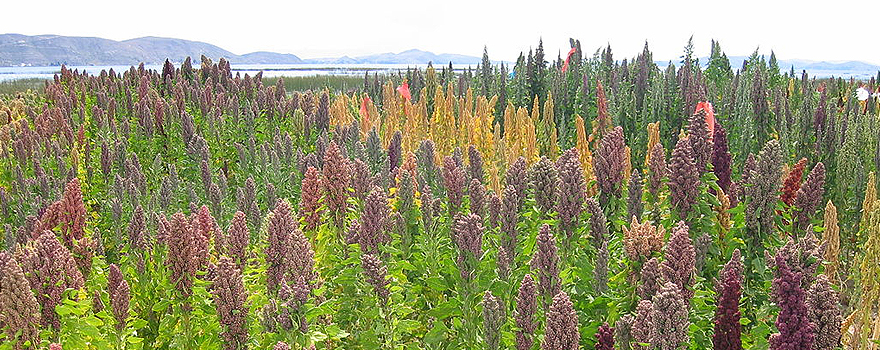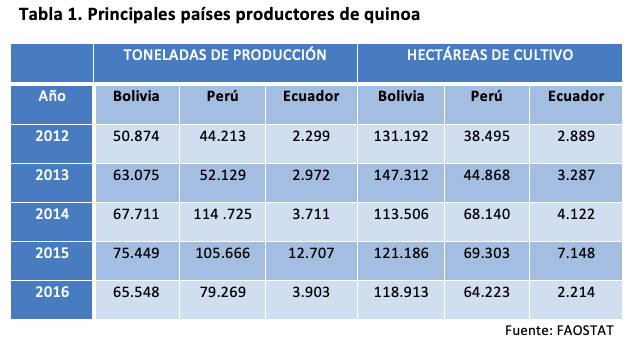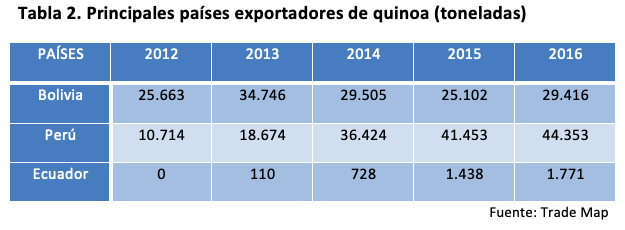Global interest in this trendy grain has brought additional income to Andean communities
The location of quinoa production, especially in Peru and Bolivia (together they account for almost 80% of the world's exports), has given these nations an unexpected strategic value. The high protein component of this pseudocereal makes it attractive to those countries that have food security as a priority.

▲ Quinoa field in the Bolivian Andes [Michael Hermann-CC]
article / Elisa Teomiro
Quinoa, which is also called quinoa (in Latin Chenopodium quinoa), is an ancestral grain more than 5,000 years old cultivated by pre-Columbian Andean cultures. After the arrival of the Spaniards in America, it was partly displaced by the cereals that were brought from the peninsula. It does not belong to the grass family but to the chenopodiaceae family (spinach, chard or beets); Therefore, it is more correct to consider it as a pseudocereal.
It is the basis of the diet of the Andean population of South America, especially in the high Andean areas of Bolivia and Peru (between the two countries they concentrate approximately 76% of the total volume of quinoa exported in the world, 46% Bolivia and 30% Peru). At present, due to its adaptation to different climates (it survives frost, high temperatures, lack of oxygen in the air, lack of water and high salinity), its production has diversified and more countries produce it: Ecuador, Venezuela, Colombia, Chile, Argentina, USA and Canada. in the Americas, as well as Great Britain, Denmark, Finland, France, Sweden, Holland, Spain, Australia and the USSR, outside of it.
Quinoa has gone from being a perfect unknown, for the majority of the non-American population, to suffering a spectacular rise in a very short time. One of the reasons for this was the decision by the Food and Agriculture Organization of the United Nations (FAO) to declare 2013 as the International Year of Quinoa. FAO wanted to reward the great effort being made by the Andean peoples to preserve grain in its natural state, as food for current and future generations. The activities carried out during that year made quinoa and its nutritional properties known to the world.
Price Increase
The interest aroused by this grain tripled its price between 2004 and 2013, which curiously generated a discussion on a possible negative impact on producer populations. Thus, it was alleged that the high demand for this crop by developed countries had turned quinoa into a "article in the producing countries, where it already cost more than chicken or rice. It was considered that this status It could cause malnutrition in the Andean population, as they are unable to supplement their scarcity per diem expenses with quinoa.
A follow-up on this issue later showed that the quinoa boom was actually helping the communities at source. A study carried out by the International Trade Centre, a joint agency of the World Trade Organization and the United Nations based in Geneva, carried out over the period 2014-2015, pointed out that the consumption of quinoa by developed countries improved the living conditions of small producers; most of them are women.
Of agreement With this study, the rise in prices between 2004-2013 meant that both producers and consumers in producing regions benefited financially from trade. Thus, there was a 46% increase in their well-being in this period, measured through the value of goods and services consumed by families. The report It also highlighted how, on the contrary, the 40% drop in the price of quinoa grain, suffered towards the end of 2015, caused a decrease in the well-being of rural households (food consumption fell by 10% and wages by 5%). The study reached two clear conclusions: the continued decline in quinoa consumption in Peru since 2005 was probably due more to the change in consumer preferences due to globalization and the increased supply of products, than to the variation in grain prices; The global consumption of quinoa in developed countries undoubtedly contributed to the development of communities in the highlands with a lack of resources.
Production and trade
The reasons why this grain has become so attractive to consumers in Europe and the USA – increasingly also in China and Japan – are several: its protein content is very high, between 14% and 18%, and it is also proteins of high biological value that would allow it to be a substitute for animal protein (it contains the 10 essential amino acids for the production of animal protein). per diem expenses human). This factor, together with its high iron content, make it an ideal pseudocereal for vegetarians; It does not contain gluten so celiacs can also consume it; it has a low glycemic content and this allows it to be consumed by diabetics; Its fiber and unsaturated fatty acid content (mainly linoleic acid) is high, so all those concerned about their health have an option in quinoa. It's also a source It is rich in vitamin E and B2 (riboflavin) and is high in calcium, phosphorus, magnesium, potassium and iron. For all these reasons, the FAO considers that due to its high nutritional value financial aid to eradicate hunger and malnutrition.
 |
The ranking of quinoa-producing countries is headed by Bolivia (its 118,913 hectares of cultivation accounted for 60% of the total quinoa planted area in the world in 2016), followed by Peru (64,223 hectares, representing 30% of the world's planted area) and Ecuador (2,214 hectares) [Table 1]. From 1990 to 2014, the area planted with quinoa went from 47,585 hectares to 195,342 hectares. The global value of exports increased from $135.5 million in 2012 to $321.5 million in 2015.
In terms of export volume in tons, Bolivia was the leading country in 2012 (more than 25,000 tons), which together with exports in 2013 represented an income of 80 million dollars for the country. In that same year, Peruvian quinoa exports exceeded 10,000 tons, which brought the country 38 million dollars into revenue. In 2014, Peru took over and dominated the market in 2015 and 2016 as well [Table 2].
The U.S. is the world's leading importer of quinoa, with 40%; it is followed by the European Union, with more than 30% of the total (France, Holland, Germany, Great Britain, Italy and Belgium mainly) and then Canada. The average price per kilogram of quinoa was $3.2 in 2012 and $6.2 in 2014. In 2015 it dropped to $5. Per capita consumption is logically led by the two main producers: Bolivia consumes 5.2 kilos and Peru 1.8 kilos, followed at a distance by Ecuador, with 332 grams per person.
In non-producing countries, quinoa was first introduced into the organic sector, with consumers concerned about healthier diets, although today it is no longer exclusive to this market. The largest consumer of quinoa per capita worldwide is Canada, with more than 180 grams, followed closely by the Netherlands; France and Australia consume between 120 and 140 grams. In Spain, consumption is still small, around 30 grams. Global forecasts until 2025 are that per capita consumption of 200 grams will be reached (an achievement that Canada already has within reach) and that even traditional rice-consuming countries, such as Japan and South Korea, will also embrace quinoa.
Quinoa production has problems for the future of both subject environmental and market. Before its boom in 2013, nearly 60 different varieties of the grain were grown in the Andean highlands and virtually all quinoa was organic. Today, unbridled trade and large-scale production on large farms has reduced biodiversity to fewer than 20 different types.
 |
The forecasts of the market research A study commissioned by the Trade for Development Center in 2016 on current and future markets for quinoa indicates that in ten years it is very likely that the global market will double, especially with conventional quinoa produced not only in Peru, but also in Australia, the United States and Canada. The production of organic quinoa, produced by small farmers in the highlands, will remain relatively stable. The skill The market will continue to be fierce, so farmers in the highlands will have to look for measures that will allow them to continue maintaining a market niche with certified organic quinoa, grown from traditional and fair trade methods.